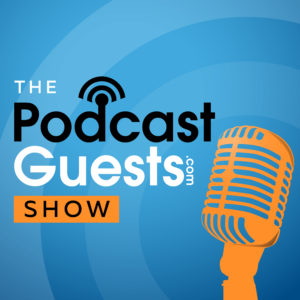
Now is a great time to start a podcast, but you may be wondering how to start. In episode #2 of The Podcast Guests Show, I’ll walk you through the process. You can listen here:
The prevailing advice I can give you is: don’t overthink it! Trying to make everything perfect can set you back. There are some things you have to get right on the first go, but it’s okay to add improvements to your show over time. Don’t let perfection be the enemy of progress.
Step 1: Naming
Keep in mind that some podcast apps, including Apple podcasts, use your title as the main part of search. They aren’t searching inside your shows for keywords, so make sure your title tells people what your show is about.
I see lots of people naming their podcast after themselves, such as “The Susan Smith Podcast,” or the “The Brian White Podcast.” This works if you have an existing brand but not if you’re building one. Instead, add descriptors into the title, such as “Cool Entrepreneurs with Susan Smith” or “Insurance Insights with Brian White.” Also, make sure no one has already started using your show name, and make sure there are no trademarks on it.
Step 2: Cover Art
This is one of the areas where you shouldn’t skimp! A few tips for the art:
- It’s small, so make sure it’s designed with that in mind. Don’t make the type or artistic elements too small.
- Make sure it doesn’t have a true white background on the edges because this will disappear on the podcast app.
- Invest in a quality graphic—you won’t regret it.
Step 3: Sound
You need an external mic, and this is one of those things that is necessary before you start. You don’t want to overthink your sound setup, but you do need a decent mic. These can cost under $100.
Right now, I use a Rode Procaster, which is a few hundred dollars. But you can find good mics, especially by brands like Audio-Technica for $100 or less.
A few tips for sound:
- Make sure to get a microphone that is dynamic (not condenser).
- Try recording in a walk-in closet or a room with carpet or with a bed with bedding.
- Consider upgrading to sound panels later on, especially if you are experiencing an echo.
Step 4: Pick a Format
The most common format for podcasts is to have guests. You can also do solo, co-hosts or a mix of these.
Consistency in length and publish schedule are the two things to focus on. You might not know how long your episodes should be at first — that’s ok. There’s no right answer. Just try things out and gather listener feedback. Also, publish the same time every week or whatever your cadence is so listeners can work this into their schedule.
Step 5: Hosting
There are lots of podcast hosts out there, and most of them do just fine. It’s a pain to change podcast hosts, so don’t just go with what’s cheap or easy.
You can get a solid account with Libsyn for $5, and it’s $2 more for basic stats. Use code SAVE to get 2 months free.
What’s too cheap? Free. If hosting is free, you are the product.
Step 6: Recording & Editing
You have a name, cover art, a mic, a hosting account, and a place to record. Now you need to decide how to record and edit your show.
If you’re just recording yourself, your computer probably comes with decent capturing and editing software. I’m on a PC, and Audacity is great for this, and it’s free.
If you’re recording guests, a simple solution is to use one of the audio recording services built specifically for podcasting—Squadcast, Riverside.fm, Zencastr, etc. The idea behind these is that they record both sides of the convo on each side, which is called a double-ender. These podcast-specific recording services are about $20 a month or so, and worth it if you’re recording guests each week.
Editing takes care of the things that make your show seem amateur and makes it sound professional. The good news is there are lots of podcast editors out there who are pros at this and will do it for you. I upload my files to a Google Drive folder and then podcastfasttrack.com edits them, uploads them to my podcast host, and schedules them for publishing.
Other Recording tips:
- Pick intro/outro music that is royalty-free. Try Premiumbeat or Audio Jungle for good ones under $50.
- To save money, you can skip paying for voiceover talent at first.
Step 7: Publishing
There are two parts of publishing: one is publishing with your host so that you have a file on the internet that can be downloaded into a podcast app. The other is getting your podcast on those apps.
Start with Apple Podcasts. Apple’s podcast directory is behind 60-70% of all downloads according to Libsyn. Most of these are through Apple itself, but also other directories add you once you’re in Apple.
I recommend creating a pilot episode and then submitting to the directories, that way you’ll be in there when you launch. Also, do it early to make sure it’s in there when you’re ready to launch.